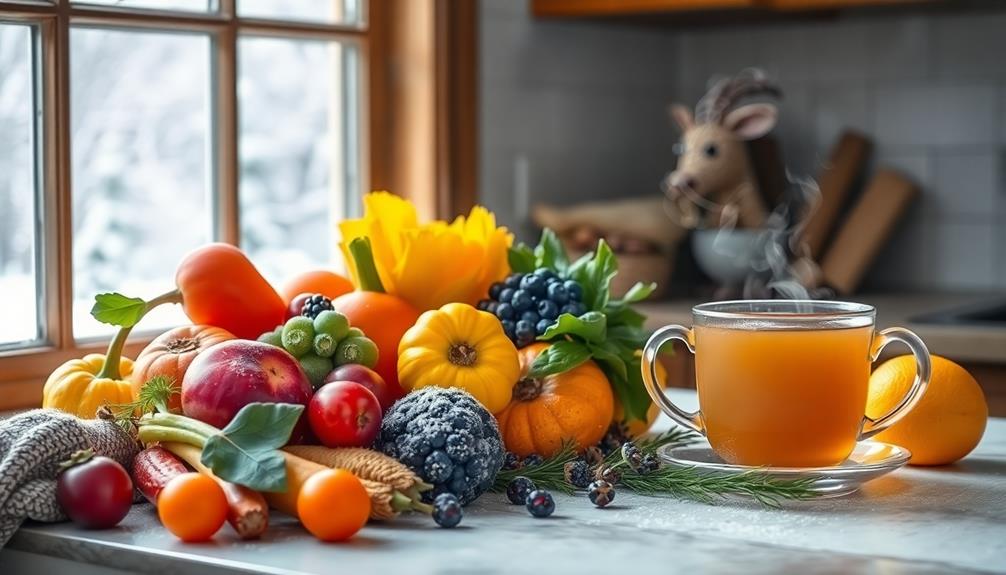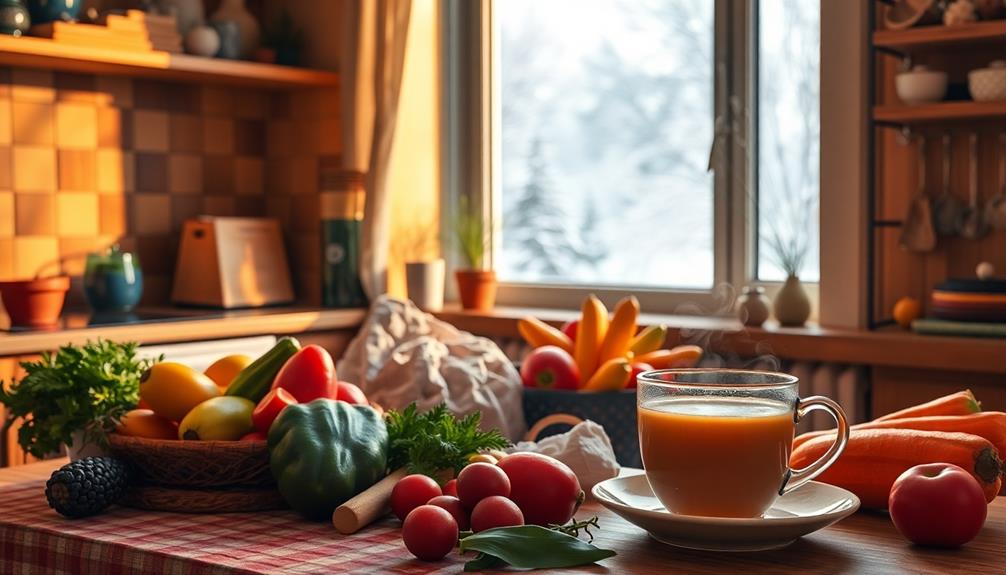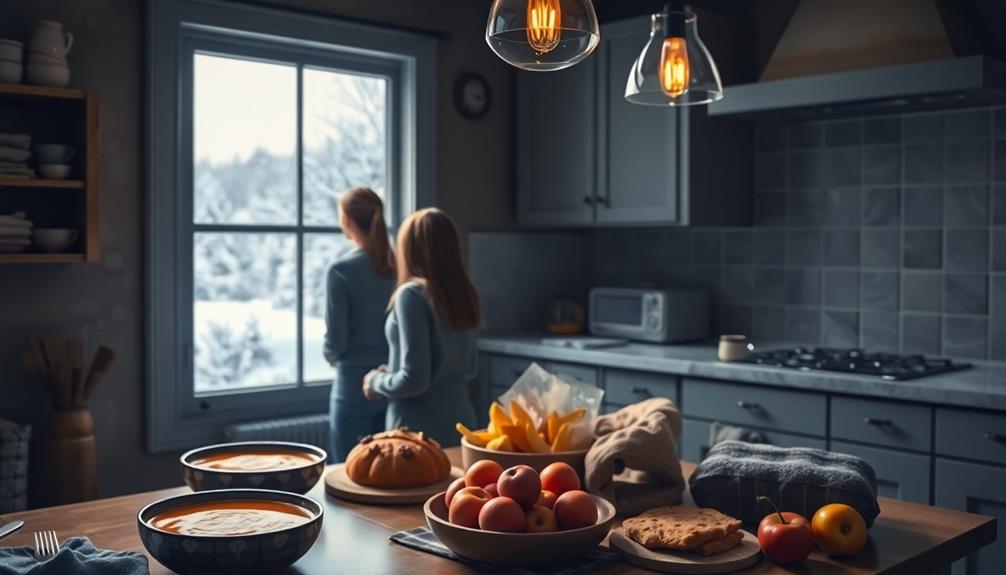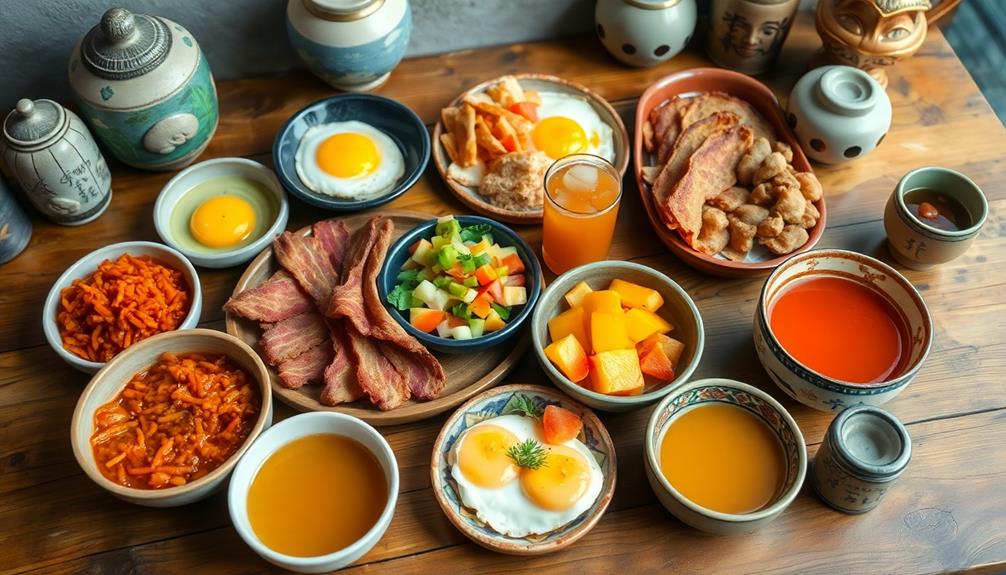Seasonal Affective Disorder (SAD) can greatly impact your food cravings, especially during the darker months. As sunlight decreases, serotonin levels dip, leading you to crave more carbohydrate-rich comfort foods. These carbs can temporarily boost your mood by increasing serotonin, providing short-lived relief from SAD symptoms. You may also find yourself drawn to emotional eating, which often results in binge-eating patterns. To manage these cravings effectively, focus on complex carbohydrates paired with lean proteins and nutrient-rich foods. There's much more to uncover about how to address your cravings and improve your overall wellbeing during this challenging time.
Key Takeaways
- Seasonal Affective Disorder (SAD) leads to decreased serotonin levels, increasing cravings for carbohydrate-rich foods to temporarily boost mood.
- Women with SAD are more prone to binge-eating disorder, linking emotional cravings to coping mechanisms for sadness.
- Disrupted circadian rhythms during darker months enhance appetite for comfort foods, impacting overall eating behaviors.
- Consuming complex carbohydrates alongside lean proteins can stabilize serotonin levels and manage cravings effectively.
- Regular exposure to natural light and consistent routines can alleviate SAD symptoms and reduce unhealthy food cravings.
Understanding Seasonal Affective Disorder

Seasonal Affective Disorder (SAD) is more than just the winter blues; it's a serious type of depression that affects about 5% of adults in the U.S., particularly in northern regions. If you find yourself feeling down during the fall and winter months, you might be experiencing SAD.
This disorder often manifests through symptoms like persistent sadness, low energy, and changes in sleep patterns. People may also find comfort in food during these times, often leaning towards hearty meals such as Mushroom Masala or comfort desserts like Rasgulla, which can provide a temporary mood boost.
You may notice mood fluctuations, and those feelings can lead to unhealthy eating behaviors. Many people with SAD have increased cravings for carbohydrate-rich foods, as they subconsciously seek boosts in serotonin to lift their mood.
It's important to recognize that women are three times more likely to experience SAD than men, and its prevalence increases with distance from the equator.
SAD is classified as Major Depressive Disorder with a Seasonal Pattern and is linked to disruptions in circadian rhythms and decreased sunlight exposure. Understanding these symptoms can help you identify if you or someone you know is affected.
Fortunately, treatment options like light therapy, antidepressants, and psychotherapy can alleviate these symptoms and improve overall well-being.
Connection Between SAD and Cravings

When you're grappling with Seasonal Affective Disorder (SAD), your body's biological mechanisms can drive you toward carbohydrate-rich foods.
These cravings often stem from a need to boost serotonin levels, especially during the darker months.
Incorporating seasonal ingredients, such as those found in farm-to-table cooking, can provide the nutrients your body craves while also supporting your mood.
Understanding this connection can help you explore nutritional strategies to manage your mood and cravings more effectively.
Biological Mechanisms Explained
During the winter months, many people with Seasonal Affective Disorder (SAD) experience a significant dip in serotonin levels, which can trigger intense cravings for carbohydrate-rich foods. This craving stems from the body's attempt to boost serotonin, as carbohydrates temporarily elevate serotonin levels. Reduced sunlight exposure disrupts your circadian rhythms, leading to mood changes and an increased appetite for comfort foods.
Additionally, changes in melatonin production during winter can disturb your sleep patterns, further influencing cravings and eating behaviors. Research shows that those with SAD often have heightened activation after consuming carbohydrates, while others may feel sedated, indicating a unique physiological response. Alarmingly, nearly 24.4% of women with SAD also meet criteria for binge-eating disorder, highlighting the overlap between seasonal mood disorders and abnormal eating patterns.
Here's a quick summary of the biological mechanisms:
| Mechanism | Effect on Cravings | Relation to SAD |
|---|---|---|
| Decreased serotonin levels | Triggers carbohydrate cravings | Contributes to mood changes |
| Disrupted circadian rhythms | Increases appetite for comfort foods | Affects sleep patterns |
| Melatonin changes | Disturbs sleep, influencing eating behaviors | Exacerbates SAD symptoms |
| Binge-eating disorder overlap | Indicates abnormal eating patterns | Links mood and eating |
Seasonal Food Cravings
As winter's chill sets in, many people find themselves reaching for comforting, carbohydrate-rich foods. If you're one of those who experiences seasonal affective disorder (SAD), you might notice that these cravings intensify during the colder months.
This link between SAD and cravings is primarily due to decreased serotonin levels caused by reduced sunlight exposure. Your body craves carbohydrates, as they can help boost serotonin production temporarily. Many traditional Asian cuisine dishes, rich in comforting flavors, can provide a satisfying way to fulfill those cravings while also nourishing your body.
Consider the following aspects of how these cravings manifest:
- Eating carbohydrate-rich foods can activate mood and energy levels, providing a short-term lift.
- Many individuals with SAD also struggle with binge-eating disorder, highlighting the overlap between mood and eating patterns.
- The combination of shorter days and increased melatonin can disrupt your normal eating habits.
These cravings aren't just about hunger; they can be emotionally charged. You may find yourself seeking comfort in food as a way to cope with the symptoms of SAD.
Understanding this connection can help you navigate your cravings more effectively and recognize when they might signal deeper emotional needs. For example, if you find yourself constantly craving unhealthy foods, it might not just be because you enjoy the taste, but because you are seeking comfort or stress relief. This understanding can also extend to other behaviors, such as watching mukbang videos, which can have a profound psychological impact on some individuals. By recognizing the emotional and psychological impact of mukbang videos, you can start to address your cravings from a more holistic perspective and find healthier ways to fulfill your needs. Once you become aware of the deeper emotional and psychological impact of mukbang videos, you can begin to explore alternative activities that bring you comfort or stress relief. This could include activities such as exercise, meditation, or engaging in hobbies that bring you joy. By addressing the root cause of your cravings and finding healthier ways to fulfill your emotional needs, you can create a more balanced and fulfilling lifestyle for yourself. Understanding the psychological impact of mukbang videos can be a powerful tool in taking control of your cravings and improving your overall well-being.
Nutritional Strategies Suggested
Many people facing Seasonal Affective Disorder (SAD) can benefit from targeted nutritional strategies to help manage their cravings. When winter rolls around and sunlight decreases, your serotonin levels can dip, leading to cravings for carbohydrate-rich foods.
Instead of giving in to sugary snacks, focus on consuming complex carbohydrates, like whole grains, which can stabilize serotonin levels and provide a steady mood boost. Incorporating dishes like Cuscuz Paulista can also introduce beneficial nutrients while celebrating diverse flavors.
To maximize the benefits, pair these complex carbs with lean proteins. This combination enhances the absorption of tryptophan, an amino acid essential for serotonin production. Additionally, include foods rich in Vitamin B6—like chicken, fish, and bananas—into your diet, as they play a significant role in serotonin synthesis and can help alleviate mood fluctuations.
Don't forget about Omega-3 fatty acids either! Fatty fish, walnuts, and flaxseeds are excellent sources that may support serotonin levels and improve your overall mood.
Nutritional Strategies for Managing Cravings

When you're dealing with cravings during the winter months, focusing on nutritional strategies can make a big difference.
Incorporating complex carbohydrates and pairing them with lean proteins can help stabilize your mood and manage those urges. For instance, enjoying a hearty dish like Red-Braised Pork Belly can provide both comfort and essential nutrients.
Timing your nutrient intake effectively also plays an important role in maintaining your serotonin levels and overall well-being.
Complex Carbohydrates Benefits
Understanding the benefits of complex carbohydrates can be a game-changer in managing cravings, especially during the winter months when Seasonal Affective Disorder (SAD) often triggers increased appetite.
Traditional Italian dishes, such as pasta with tomato sauce, often feature complex carbohydrates that not only comfort the soul but also support serotonin production, which plays an essential role in mood regulation. This can help mitigate those relentless cravings for quick energy sources.
Consider these benefits of adding complex carbohydrates to your diet:
- Stabilized blood sugar levels: Foods like quinoa, brown rice, and whole wheat bread release glucose steadily, reducing the likelihood of sudden cravings.
- Improved satiety: Regular consumption of complex carbohydrates can lead to decreased hunger, making it easier to resist unhealthy snacks.
- Sustained energy: These foods provide a long-lasting energy source, counteracting your body's natural craving for sugary, simple carbohydrates.
Protein Pairing Techniques
Pairing lean proteins with complex carbohydrates can greatly boost your mood and help manage cravings during the winter months. When you eat foods like tuna sandwiches on whole wheat bread or grilled chicken with brown rice, you're enhancing tryptophan absorption, which is essential for serotonin production. This is particularly important for those dealing with Seasonal Affective Disorder (SAD), as it can help stabilize your mood and reduce cravings.
Additionally, incorporating comforting foods like Dorayaki (Red Bean Pancake) can provide a sweet treat that satisfies cravings without compromising your nutritional goals.
Incorporating protein-rich foods, such as eggs and fish, alongside complex carbohydrates stabilizes blood sugar levels. This balance minimizes those intense cravings for carbs that often strike during winter. Additionally, including vitamin B6-rich foods like chicken, fish, and bananas can further support serotonin production, addressing the mood dips linked to SAD.
To maximize the benefits of protein pairing, aim to eat regularly timed meals that include these combinations. This approach signals your body to maintain energy levels and wakefulness, counteracting the lethargy that often accompanies the SAD season.
Nutrient Timing Importance
To effectively manage cravings during the winter months, it's vital to pay attention to nutrient timing, especially concerning carbohydrate intake. This approach can greatly influence your serotonin levels, helping to stabilize mood and reduce those pesky cravings associated with Seasonal Affective Disorder (SAD).
Incorporating flavors from Mexican cuisine can also provide comfort and satisfaction during this time, making meals not only nutritious but enjoyable.
Consider these strategies for ideal nutrient timing:
- Enjoy complex carbohydrates like whole grains in the morning to promote a steady release of serotonin throughout the day.
- Pair carbohydrates with lean protein at meals, such as a tuna sandwich on whole wheat, to enhance tryptophan absorption, important for serotonin production.
- Incorporate vitamin B6-rich foods, like chicken and bananas, into your meals to further support serotonin levels.
Regular meal timing, especially breakfast, signals your body to wakefulness, combating low energy and cravings.
By focusing on nutrient timing, you can effectively manage cravings and improve your mood during the winter months. Prioritizing complex carbohydrates, lean proteins, and vitamin B6 will make a considerable difference in your overall well-being.
Impact of Carbohydrates on Mood

Carbohydrates play an essential role in influencing mood, especially for those dealing with Seasonal Affective Disorder (SAD). When winter hits, you might find yourself craving carbohydrate-rich foods. This isn't just your imagination; these foods can temporarily boost serotonin levels, leading to an improved mood.
Here's a quick overview of how carbohydrates affect your mood:
| Type of Carbohydrate | Effect on Serotonin | Mood Impact |
|---|---|---|
| Simple Carbohydrates | Quick spike | Short-term elevation |
| Complex Carbohydrates | Steady release | Sustained stability |
| Refined Carbohydrates | Rapid drop | Potential crash |
| Whole Grains | Sustained release | Long-term improvement |
When you consume carbohydrates, they help your body absorb tryptophan, an amino acid vital for serotonin production. Research shows that people with SAD often experience activation and mood improvement after eating carbs, contrasting with those without SAD who might feel sedated. This response may be your body's way of combating the low serotonin levels linked to reduced sunlight exposure in winter. Choosing complex carbohydrates, like whole grains, can provide a steady release of serotonin, helping stabilize your mood and mitigate SAD symptoms.
Lifestyle Changes to Alleviate Symptoms

Managing Seasonal Affective Disorder (SAD) involves more than just what you eat; lifestyle changes can greatly improve your mood and overall well-being. Incorporating comfort foods, like a Loaded Baked Potato, can provide a sense of warmth and satisfaction during the colder months, which may help reduce cravings for less nutritious options.
By making some adjustments to your daily routine, you can help alleviate disorder symptoms and enhance your energy levels. Here are three effective strategies to take into account:
- Increase natural light exposure: Start your day by spending time outdoors or near bright windows. This helps regulate your circadian rhythms and can considerably boost your mood, reducing cravings for carbohydrate-rich foods.
- Establish a consistent routine: Regular meal times and sleep schedules help combat low energy levels. Consistency can stabilize your mood and minimize mood swings often experienced during winter months.
- Engage in physical activity: Regular exercise, such as daily walks or indoor workouts, can elevate serotonin levels, which may lessen cravings for unhealthy snacks and improve your overall mood.
Additionally, think about incorporating light therapy into your routine. Spending 20-60 minutes each day in bright artificial light can alleviate SAD symptoms, including abnormal food cravings.
With these lifestyle changes, you can take proactive steps to manage your symptoms effectively.
Seeking Professional Help and Support

Seeking professional help and support can be an essential step in managing Seasonal Affective Disorder (SAD) and its associated food cravings. When you experience SAD, cravings for carbohydrate-rich foods can intensify as your body seeks to boost serotonin levels. This often leads to unhealthy eating patterns that can spiral into more serious issues, including binge-eating disorder.
Incorporating nutritious foods, such as a revitalizing Yeselata (Ethiopian Salad), can provide a satisfying and healthy alternative to these cravings while also celebrating the diversity of agricultural produce.
Getting professional help is important in addressing these cravings and their impact on your overall health. Treatment options like light therapy and psychotherapy can greatly alleviate SAD symptoms, helping you regulate your appetite and cravings more effectively. An individualized treatment plan is fundamental, as it will cater to both your mood regulation and nutritional needs, promoting a healthier relationship with food.
Don't hesitate to reach out to healthcare providers who specialize in eating disorder treatment and SAD. Additionally, community resources and specialized treatment centers can offer essential education and support to help you navigate the complexities of SAD and its effects on your eating habits.
Frequently Asked Questions
Does Seasonal Affective Disorder Affect Appetite?
Yes, Seasonal Affective Disorder definitely affects your appetite. The lack of sunlight can lead to changes in your mood and energy levels, which may result in increased cravings for certain foods, especially carbohydrates.
Can Seasonal Depression Cause Eating Disorders?
Imagine a garden wilting in winter's chill. Seasonal depression can indeed sow the seeds of eating disorders, as your mood and cravings intertwine, making it essential to nurture both mental health and nutrition for growth.
How Does Seasonal Affective Disorder Affect Daily Life?
Seasonal Affective Disorder can drain your energy, disrupt sleep, and hinder your concentration. You might find daily tasks overwhelming, leading to isolation and diminished productivity, which can further compound feelings of sadness and hopelessness.
Can Depression Cause Food Cravings?
You might not realize it, but depression can trigger intense food cravings. Your body seeks comfort and energy, often leading you to crave sugary or carbohydrate-rich foods, which temporarily boost your mood and energy levels.
Conclusion
In summary, understanding how Seasonal Affective Disorder influences your food cravings can be a game changer for your wellbeing. Curiously, some studies suggest that cravings for carbs might be your brain's way of seeking a serotonin boost during darker months. By focusing on nutritional strategies and making lifestyle changes, you can manage these cravings more effectively. Don't hesitate to reach out for professional support if you need it; you're not alone in steering through this seasonal struggle.









